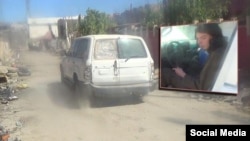An Australian teenager who ran away to Iraq to join the Islamic State (IS) group may have been killed in a suicide car bombing in the Iraqi town of Ramadi.
IS Twitter accounts on March 11 posted photographs of several foreign militants they claimed had perpetrated a series of suicide truck bombings in Ramadi. One of the photographs showed a white van, with an inset image of the alleged driver, who looked like 18-year-old Jake Bilardi.
Text accompanying the image said that the suicide bomber was "Abu Abdullah al-Australi." Bilardi has previously been associated with the name Abu Khattab al-Australi.
Other pro-IS accounts tweeted images that claimed to show Bilardi in Iraq, praising the Australian teen as a "martyrdom seeker."
Police in Australia are investigating whether the young man shown in the image is Bilardi, The Wall Street Journal reported. The newspaper also reported having seen a blog believed to be by Bilardi, the authenticity and authorship of which is still unconfirmed. The post was reportedly written on January 13 and talks about plans for a "string of bombings across Melbourne, targeting foreign consulates and political/military targets as well as grenade and knife attacks on shopping centers and cafes, and culminating with myself detonating a belt of explosives amongst the kuffar [infidels]."
The car bombings in which Bilardi is believed to have participated took place in Ramadi in Iraq's Anbar Province on March 11. The attacks targeted Iraqi Army positions and were carried out by suicide bombers in 13 vehicles. An Iraqi medical source said that five people were killed in the attacks, though the real death toll could be significantly higher, according to Reuters.
According to the Twitter posts by pro-IS accounts, the suicide bombers were foreign militants. Alongside Abu Abdullah al-Australi, the bombers included an Uzbek militant named as Osama bin Laden al-Uzbeki and a Syrian militant named as Abu Hassan al-Shami. The photograph of the alleged Syrian militant shows a very young man, possibly a teenager.
Targeting Australian 'Militant Returnees'
As more details of Bilardi's apparently sudden radicalization and his decision to go to Iraq to fight alongside the IS group emerged in Australia this past week, a new Australian nongovernmental organization announced plans to target militants returning home after fighting with IS.
Dr. Clarke Jones, one of the founders of the Countering Extremism NGO, told ABC news on March 10 that individually tailored approaches were required to help militants and others who have been radicalized. "Each person needs to be done on a case-by-case basis," Jones said.
Diversionary programs would target individuals who had become radicalized and were close to breaking the law, while prison de-radicalization programs could help those who had already been sentenced, Jones said.
Young people like Bilardi who had become radicalized should be targeted with diversionary programs, Jones said.
Bilardi is not the first Australian IS militant to have hit the headlines in Australia. In August, an image of an Australian IS militant holding aloft two severed heads was posted online. The militant, believed to be Sydney resident Mohamed Elomar, offered a bounty of $1,000 for information on a Sydney Muslim community leader.
Also in August, another Australian militant posted a grotesque image of his 7-year-old son holding up a severed head.
-- Joanna Paraszczuk
